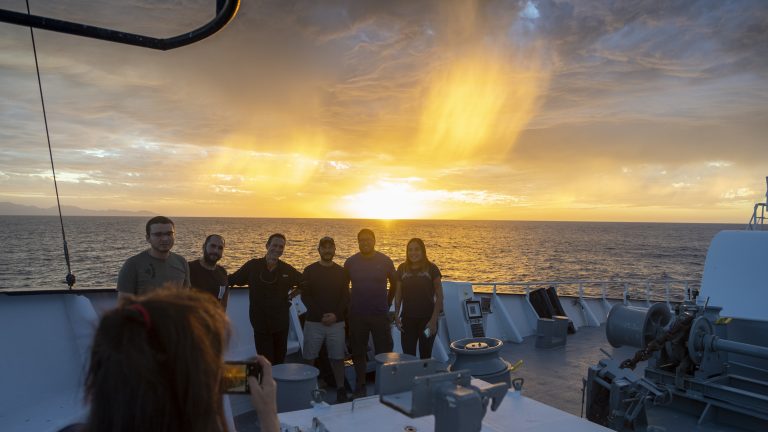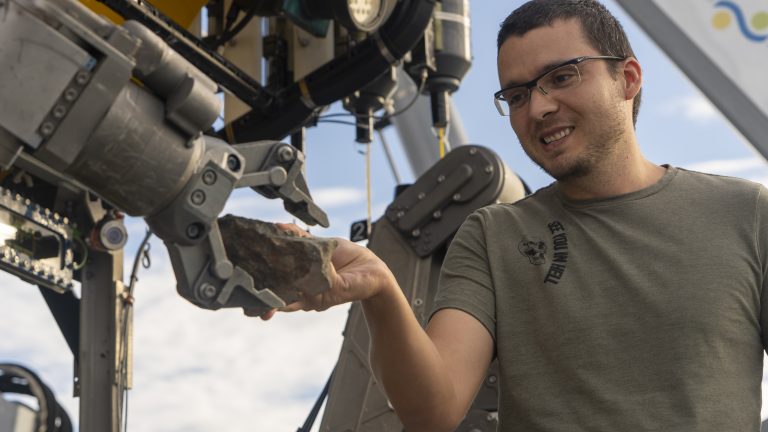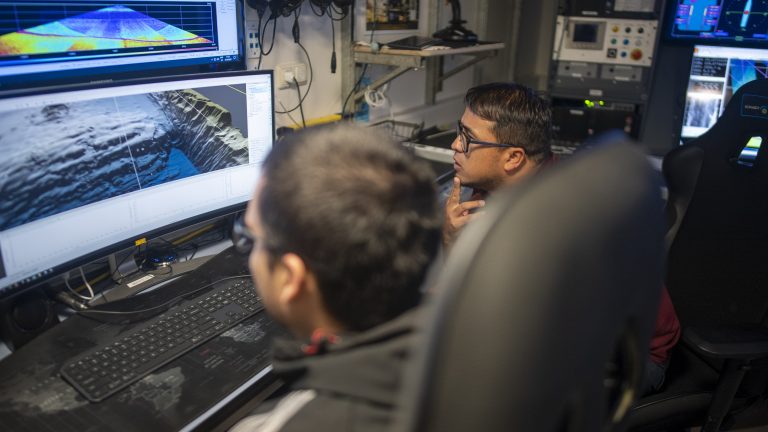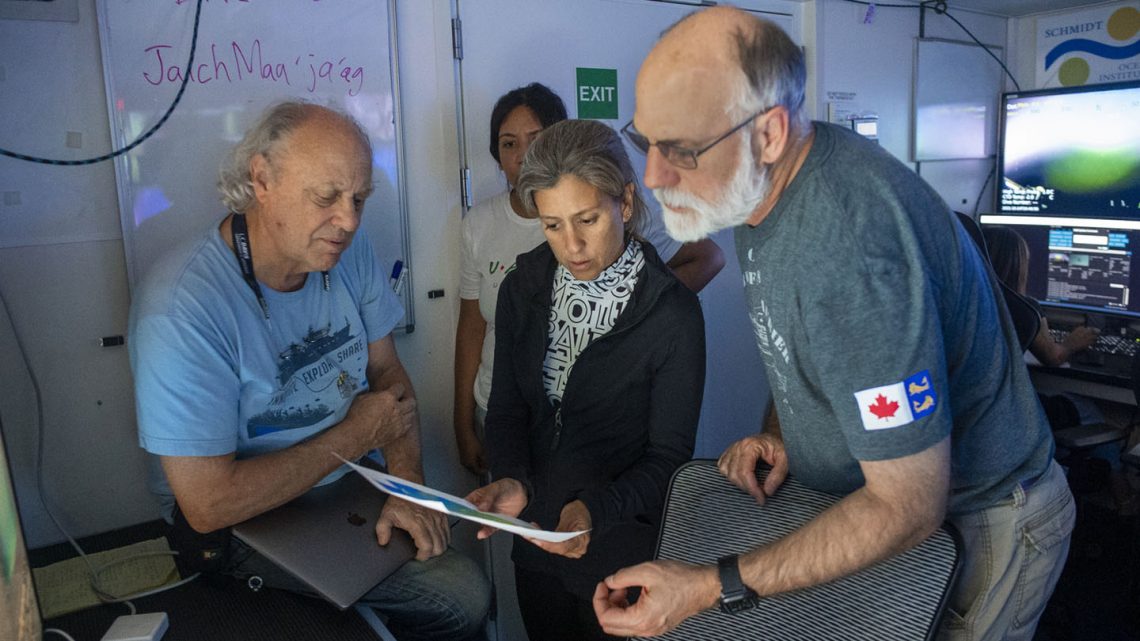The following is the opinion of Monika Naranjo-Shepherd. Taducción al español a continuación.
The other day I was browsing through my social media feed and I came across a meme that really resonated with me. It depicted Santa looking at a laptop, and it read: “Santa has been reading your posts all year. Most of you are getting science books.”
I could not help but wonder if we did get science books this Christmas, would we read them? Would most of us be able to understand them? And if the answers to those questions are no, who is at fault?
A drop of knowledge
It has been several weeks since we started sailing onboard R/V Falkor for the “Interdisciplinary Investigation of the Pescadero Basin” expedition. The scientific team from Leg 2 has left, and we have welcomed a new batch of brilliant minds who will explore the heat flow inside the hydrothermal vent fields. The effort to make this expedition happen was monumental: the ship logistics, the permits, the Covid19-related hotel quarantines, the equipment necessary, the scientific and special personnel involved… And those were the easy parts.

In spite of having dedicated my career to designing stories of scientific value, I am still astounded by the amount of work and humility that it takes to distill a single drop of scientific knowledge. Every scientist stands on the shoulders of those that preceded them, building upon the collective cognition about a single subject, many times without even knowing what the practical applications of their efforts could be but simply following the desire to learn and to understand the world and the universe.
Scientists ask questions and then they try to answer them. Most of us do that at some point, but here is the key difference between them and us: they cannot simply decide that they are right because they want to be right. Nor simply because the answer seems to be true. Scientific research must withstand a gigantic burden of proof – even the shortest of papers about the most minuscule of studies must be peer-reviewed and go through what seem to be countless iterations. Just to produce an idea that can be used by others as a tool to develop their own science.

Which is where the humility component comes in. Scientists must accept that they may be wrong, and that their proposals will be disputed or even discarded. This might not be the end result they hope for, but they also understand that this discriminatory process takes them, and the whole scientific community, closer to finding some part of universal truth.
Scale
Apparently, when something really big happens, our natural human response is to try to attribute an equally large origin to that event. For example, nothing as huge as a pandemic could be attributed to something as familiar and small as a virus. No no! It must be due to some incredibly convoluted conspiracy.
I get it. We all relish control. The illusion of being able to see something that no one else seems to see gives us a sense of comfort through turbulent times. This is a luxury that scientists cannot afford, and for that reason alone, we should respect them and follow their guidance. When researching, we should turn to them and not obscure sources that are accountable to no one.

Just like the scientists in this expedition when they look at the subsurface and the tectonics of the Gulf of California, I have also been looking at the faults and cracks in our relationship with science. Science is much more nuanced and difficult to explain than the short and overly-simplified statements that catch fire on social media. This is a massive challenge that the scientific community and those of us who work in science communication will have to address. In the meantime, I applaud everybody’s inquisitiveness, including that of those who do not believe in simple truths like the roundness of the Earth. I would just like to invite you to also question yourselves, your assertions and your sources with the same rigor that scientists do to their own painstaking research.

Fallas y grietas
La siguiente es la opinión de Monika Naranjo-Shepherd.
El otro día estaba navegando por mis redes sociales y me encontré con un meme que me llamó mucho la atención. Tenía a Santa Claus mirando un ordenador portátil, y decía: “Papá Noel ha estado leyendo sus mensajes todo el año. A la mayoría de ustedes les voy a regalar libros de ciencia”.
No pude evitar preguntarme: si nos regalaran libros de ciencia esta navidad, ¿los leeríamos? ¿Seríamos capaces de entenderlos? Y si las respuestas a estas preguntas son “no”, ¿Dónde estamos fallando?
Una gota de conocimiento
Han pasado dos semanas desde que empezamos a navegar a bordo del RV Falkor en la Investigación Interdisciplinaria de la Cuenca Pescadero. El equipo científico de la primera parte acaba de marcharse y hemos dado la bienvenida a un nuevo grupo de mentes brillantes que explorarán el flujo de calor dentro de los sistemas hidrotermales. El esfuerzo para llevar a cabo esta expedición ha sido monumental: la logística del barco, los permisos, las cuarentenas hoteleras relacionadas con el covid19, el equipo necesario, el personal científico y especial involucrado… Y esa fue la parte fácil.

A pesar de haber dedicado mi carrera a diseñar historias de valor científico, todavía me asombra la cantidad de trabajo y humildad que se necesita para destilar una sola gota de conocimiento científico. Cada científico se apoya en los hombros de aquellos que le precedieron, aumentando el conocimiento colectivo sobre un mismo tema, muchas veces sin saber siquiera cuáles podrían ser las aplicaciones prácticas de sus esfuerzos, sino simplemente siguiendo el deseo de aprender y comprender el mundo y el universo.
Los científicos se hacen preguntas y luego tratan de responderlas. La mayoría de nosotros hacemos eso en algún momento, pero la diferencia clave entre ellos y nosotros es que los científicos no pueden simplemente decidir que tienen razón porque quieren tenerla. Ni tampoco porque la respuesta parece ser correcta. La investigación científica debe pasar un gigantesco proceso de pruebas, incluso el más breve de los artículos sobre el más minúsculo de los estudios debe ser revisado por colegas especializados y pasar por lo que parecen ser innumerables iteraciones. Sólo para producir una idea que pueda ser utilizada por otros como herramienta para desarrollar su propia ciencia.

Ahí es donde entra el componente de humildad. Los científicos deben aceptar que pueden estar equivocados y que sus propuestas pueden ser discutidas o incluso descartadas. Ese no es el resultado final que desean, pero entienden que ese proceso discriminatorio les acerca, a ellos y a toda la comunidad científica, a encontrar alguna parte de una verdad universal.
Escala
Aparentemente, cuando ocurre algo realmente grande, nuestra respuesta humana natural es intentar atribuir un origen igualmente grande a ese acontecimiento. Por ejemplo, nada tan grande como una pandemia podría atribuirse a algo tan familiar y pequeño como un virus. No, no, en lugar de eso es más fácil atribuirlo a una conspiración increíblemente complicada.
Es comprensible. Todos necesitamos sentir que tenemos algo de control. El creer que podemos ver algo que nadie más es capaz de detectar, nos da una sensación de confort en tiempos turbulentos. Este es un lujo que los científicos no pueden permitirse, y sólo por esa razón, deberíamos respetarlos y seguir su guía. A la hora de investigar, debemos recurrir a ellos y no a fuentes oscuras que no rinden cuentas a nadie.

Al igual que los científicos de esta expedición cuando observan el subsuelo y la tectónica del Golfo de California, yo también he estado observando las fallas y grietas de nuestra relación con la ciencia. La ciencia es mucho más matizada y difícil de explicar que los posts cortos y extremadamente simplificados que se viralizan en las redes sociales. Este es un reto titánico que la comunidad científica y quienes trabajamos en la comunicación de la ciencia tendremos que enfrentar. Mientras tanto, aplaudo la curiosidad y criticidad de todos, incluida la de aquellos que no creen en verdades simples como la redondez de la Tierra. Sólo quiero invitarles a que también se cuestionen a sí mismos, a sus afirmaciones y a sus fuentes con el mismo rigor que los científicos aplican a sus propias minuciosas investigaciones.


